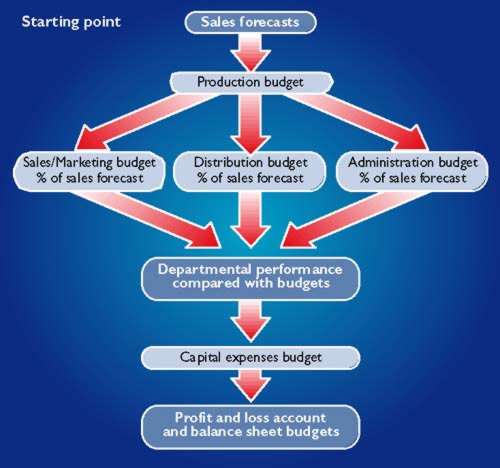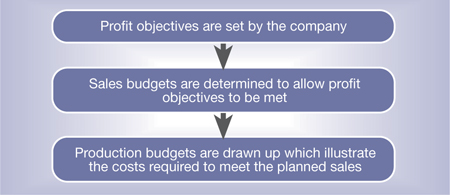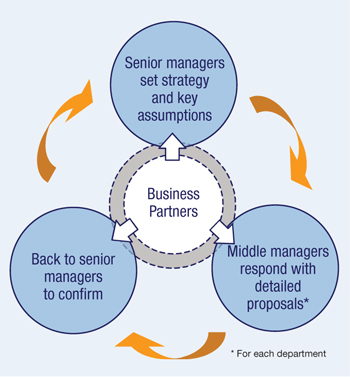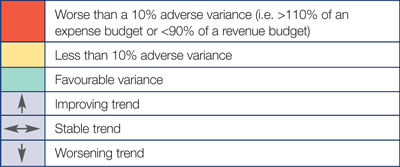
Case 11.1. «Budgeting and strategy»
What is a budget?
A budget is a financial plan that sets out, using figures, an organisation's expected future results. For planning purposes, organisations can use many different types of budgets. For example:
Income and expenditure budgets. These show how much an organisation expects to receive and to spend in future periods.
Production budgets. These set out how much an organisation must produce in coming periods of time in order to meet demand.
Profit budgets. These bring together planned sales, costs, and profit figures.
By creating budgets, managers can:
set out a clear plan, involving target figures for defined periods of time
communicate their targets clearly
motivate employees to achieve these targets
control performance by monitoring actual outcomes against planned targets
meet the organisation's objectives.
This case study illustrates how Kraft Foods uses budgets to enable it to meet business objectives related to financial performance with a view to achieving its vision: to become 'the undisputed global food leader.'
Kraft has several important objectives related to its vision. These include:
being the employer of choice
being a food industry high performer
becoming an indispensable partner to customers
being a responsible organisation and a positive force in the communities in which Kraft employees live, work and make its products remain focused and innovative.
Budgets help Kraft to meet these objectives in a planned forward-thinking way.
Budgets are created through consultation with all areas of the business, to achieve a shared understanding about objectives for the future visions of their teams. The Finance team supports and contributes to the work generated by other business functions to build and secure their support for the budget.
To be effective Kraft recognises that a budget must be challenging but also realistic, so that people feel it can be achieved and is worth working towards. One important element is to identify cost savings that can be re-invested to continue to grow Kraft's powerbrands and to develop its people. Reducing costs by eliminating waste is vital in the modern food industry which is driven by price competition and consolidation in the retail sector.
Kraft´s income and expenses budget
A typical budget:
relates to a defined time period (usually twelve months)
is designed and approved well in advance of the period to which it relates
shows expected income and expenditure - income is the amount of money a business receives from its sales.
includes all capital expenses likely to be incurred in furthering the organisation's objectives - expenses are the costs incurred in order to make those sales.
To help control expenditure the Finance team collates the costs of the business in relevant groups called cost centres, so that analysis can be meaningful and also well controlled by those directly responsible for authorising the spend.
Many companies, including Kraft, use cost centres that relate to particular factories or production units. Within Kraft each manager is assigned clear responsibility for governing the costs which are allocated to his/her cost centre.
The budgeting process enables Kraft to make clear plans for individual cost centres, which build the budget for the whole organisation. The whole purpose of this exercise is to quantify the likely future costs of the whole operation, whilst always maintaining focus on the future plans for the company.
Kraft sells its wide portfolio of products to a variety of different customers; ranging from the corner shop, to the cash and carry and large multinational supermarket chains. In doing so, it incurs:
raw material costs and production costs to manufacture the products to sell
marketing expenses associated with any promotional activity including media advertising
selling expenses involved in selling its goods into supermarkets and other customers
d
 istribution
expenses when transporting the products from its European and
UK factories to the customer.
istribution
expenses when transporting the products from its European and
UK factories to the customer.
The starting point for building a budget is to forecast the likely sales based on historical information in conjunction with Kraft's and third party understanding of the business environment. This indicates what quantities of products need to be produced and the timing of manufacture.
With these figures in place, budgets can then be allocated for costs relating to sales, marketing and administration, and figures established for the likely costs of storing and transporting the goods (i.e. distribution). These details provide data for relevant departments (e.g. sales, administration etc). Figures can then be inserted for likely capital expenses. The final stage is to construct a budgeted profit and loss account and balance sheet.
Once the budget has been set and agreed by the management teams within Kraft, it becomes the mechanism through which managers monitor progress on a particular business component (for example, a brand, or factory) or on total company performance.
The importance of feedback
The budgeting process is a cycle of ongoing review and monitoring. Every month, Kraft uses variance analysis to identify deviations within the monthly result. A variance is the difference between the budgeted figure and the actual figure.
Variances can be favourable or adverse. For example, if actual sales income was greater than budget, this would be a favourable variance. On the other hand, if actual expenses were greater than budget, this would be an adverse variance.
By monitoring performance monthly, it is possible to alert cost centre managers to variances so that they can take appropriate corrective action or justify the new level of spend. At all stages the Senior Management team of Kraft is fully aware of any material variances that are derived from comparing actual spend vs budgeted figures.
Periodic reviews which are organised by the Budget Accountant, allow there to be a forum within which any feedback can be given on current actual spend vs plan, ensure that it is possible to reforecast the plan or alter current activity.
Single loop feedback involves making correction to current activities in order to 'get back on course'.
Double loop feedback involves amending the original plans so that they more accurately reflect current business reality.
In a company like Kraft, this ability to amend the budget is an important aspect of management. Kraft's operating environment is subject to rapid change, for example, in consumer demand patterns, in production technology, in competitor activity. So Kraft has to remain flexible and ready to respond to any challenges that it faces. Any one budget may be altered a number of times during a year, although there would always be a considered reason for doing so.
Constructing an expense budget
Each cost centre budget is seen as part of an overall plan designed to meet company objectives. Constructing cost centres' individual budgets involves detailed consultation about company objectives, marketing objectives and relevant income and expense projections. These can be brought into line and match changes in the external business environment.
Using this as a basis it is a reasonably straightforward exercise to calculate other expenses, including the number of people (and their remuneration packages, such as pension expenses, national insurance, travel costs) required to run a particular part of the business.
In the modern business world the rate of change is such that it is impossible to have a clear picture of the future. Inevitably it takes time to build the 'big picture' from lots of small, shifting scenarios relating to individual cost centre budgets. Budgeting may be difficult, but it is essential for a business to stay in control and 'ahead of the game'.
Advantages and disadvantages of expense budgeting
Budgeting provides organisations with detailed analysis of future and current proposed spending patterns, enabling much better control (by responding to variances). Performance can be analysed quantitatively (in numbers), making it possible to measure financial success. Measurement of results can serve as a motivational tool for many employees.
Budget analysis also makes it possible to identify unnecessary costs that can be removed so as to focus funds on value adding activities. Kraft uses budgetary control to remain focused on the hard (quantitative) and soft (qualitative) benefits of re-distributing spend.
However, it is important to keep sight of the organisation's long term goals to avoid the risk that budgeting might lead to short-term focus on financial results. This could foster cost cutting exercises at the expense of strategy. In the worst case, individual managers may pursue exclusively their own narrow goals rather than business wide ones.
If individual managers are not happy with the budget they may co-operate poorly, so it is important to have detailed discussions to achieve collective agreement. This is why Kraft as an organisation retains a consultative approach to constructing budgets.
Alternative types of budgeting
There are a number of budgeting types to choose from. Kraft uses a mix of the following.
i. Zero based budgeting
In a dynamic business it often makes sense to 'start afresh' when developing a budget rather than basing ideas too much on past performance. This is appropriate to Kraft because the organisation is continually seeking to innovate. Each budget is therefore constructed without much reference to previous budgets. In this way, change is built into budget thinking.
ii. Strategic budgeting
This involves identifying new, emerging opportunities, and then building plans to take full advantage of them. This is closely related to zero based budgeting and helps Kraft to concentrate on gaining competitive advantage.
iii. Rolling budgets
Given the speed of change and general uncertainty in the external environment, shareholders seek quick results. US companies typically report to shareholders every three months, compared with six months in the UK. Rolling budgets involve evaluating the previous twelve months' performance on an ongoing basis, and forecasting the next three months' performance.
iv. Activity based budgeting
This examines individual activities and assesses the strength of their contribution to company success. They can then be ranked and prioritised, and be assigned appropriate budgets.
Conclusion
The world food market is dynamic and highly competitive. To succeed, Kraft recognises the need to build in flexibility that enables it to seize appropriate opportunities into its planning activities.
Kraft's budgeting process is based on consensus, and shared understandings. By using rigorous but flexible budgeting arrangements the various components of Kraft are best able to contribute in a coordinated way to delivering strategic objectives.
SOURCES:
http://businesscasestudies.co.uk/kraft-foods-uk/budgeting-and-strategy/conclusion.html#ixzz2sLBsFsTw
Discuss the questions:
1. Describe what is meant by ‘a budget’.
2. What are advantages and disadvantages of different budgeting types?
3. Analyse the process of constructing a budget. Which type of budgeting would be the most suitable to a business of your choice? Why?
Case 11.2. The benefits of budgeting
A Zurich case study
Introduction
Zurich Insurance Group is a leading global provider of insurance services. Zurich’s mission is to help customers understand and protect themselves from risk. The company employs 60,000 staff and serves customers in 170 countries around the world.
Zurich offers General Insurance and Life Insurance products, for example:
General Insurance: car insurance, home buildings and contents insurance
Life assurance: life insurance, investment and pension plans.
Zurich offers its products to retail customers (mainly individuals) and corporate customers (i.e. businesses).
Life is full of uncertainty. The building you work in could catch fire. Your computer could be stolen. You may have an accident. These are all risks with a small but real probability that they may occur. Insurance provides protection against that risk. In return for a fee (a premium) it provides a financial payment in the event of financial/personal loss.
Supporting the brand
S o
what makes Zurich one of the leading insurance companies? It starts
with Zurich’s brand, reputation for quality customer service and
solid financial strength. The insurance industry is tightly
regulated, requiring strict standards and highly skilled finance
professionals. Zurich, therefore, aims to attract the best graduates.
Zurich’s ethos is underpinned by its core values:
o
what makes Zurich one of the leading insurance companies? It starts
with Zurich’s brand, reputation for quality customer service and
solid financial strength. The insurance industry is tightly
regulated, requiring strict standards and highly skilled finance
professionals. Zurich, therefore, aims to attract the best graduates.
Zurich’s ethos is underpinned by its core values:
A key component of Zurich’s values is corporate responsibility. Being a responsible company is fundamental to Zurich’s long-term sustainability. For example, Zurich Community Trust in the UK actively helps over 600 charities make a difference to the lives of thousands every year.
Insurance is an extremely competitive market. Customers will obtain quotes to find the best value either from Zurich directly or through a financial adviser. This case study shows how Zurich’s careful approach to budgeting is a contributory factor in gaining competitive advantage.
What is a budget?
An organisation must earn enough revenue so that after all costs have been subtracted, there is a profit remaining. One of the most useful financial tools is the budget. A budget is a business plan expressed in financial terms. Budgets can be drawn up for sales, costs or investment spending. A budget will include a degree of prediction of performance which is usually based on past data, e.g. sales.
It is important that it is a realistic financial plan that the business can fulfil. Managers at all levels will have their own budget plans, designed to co-ordinate with and contribute to the overall plan or master budget. Therefore, managers need to be involved in contributing information to the budget to which they will be committed.
B udgets
should be stretching but achievable. They should enable companies to
meet both short and long-term financial and strategic objectives,
whilst providing motivational targets (potentially linked to bonus
payments) for managers to promote the right behaviours. All budgets
must be carefully monitored, reviewed and, if appropriate,
re-assessed as internal factors (e.g. a major project costs
significantly less or more than expected) and external factors (e.g.
regulatory developments) change.
udgets
should be stretching but achievable. They should enable companies to
meet both short and long-term financial and strategic objectives,
whilst providing motivational targets (potentially linked to bonus
payments) for managers to promote the right behaviours. All budgets
must be carefully monitored, reviewed and, if appropriate,
re-assessed as internal factors (e.g. a major project costs
significantly less or more than expected) and external factors (e.g.
regulatory developments) change.
Core business segments
Zurich has three core business segments: General Insurance (e.g. car, home), Global Life (e.g. life assurance, pensions and investments) and Farmers (core North-American business). These segments are divided into regions, for example, Europe, and then into business units, for example, UK Life. Through discussion with various stakeholders, budgets are set for each business unit, with the combined budgets supporting Zurich’s overall corporate aims.
For example, the table below shows the revenue and expense budgets for UK Life. The expenses budget is broken down by function. (All figures are for illustration only.)

Benefits of budgeting
Budgets are a financial representation of an organisation’s strategy. The process of budgeting requires managers to plan ahead, for example, to identify the resources required to meet targets. This is particularly important in the insurance industry due to the complex nature of the products offered. Insurance generally addresses medium- and long-term needs of customers. Decisions taken now are likely to have financial implications for many years to come.
For example, in the UK, Zurich offers a protection product which provides a payment in the event of the death of the policyholder to pay off an outstanding mortgage. Typically, this product offers protection for 15 to 25 years. Zurich guarantees a price to the policyholder for the whole term. If the outcome is different to that which was assumed when the price was set (e.g. fewer or more deaths occur or fewer or more policies are cancelled than expected), Zurich will either make a profit or a loss on that product. Due to the long-term nature of these products any profit will emerge over many years.
Analysing variances
The budgeting process can be used for monitoring and control of financial performance. Results can be reviewed as frequently as necessary against budgets to identify good and poor performance areas. Managers need to investigate the difference or variance between budgeted and actual results.
Where actual figures are worse than budgeted, these are called adverse variances. Adverse variances may suggest problems. Where budgets are not being met, action can be taken. Budget targets can be highly motivational and staff who meet or exceed budgeted targets may be rewarded with bonuses.
Challenges of effective budgeting
Suppose sales volume, prices and costs were all projected to rise annually by 10% (incremental budgeting). This would make budgeting easy, but it is highly unlikely. To increase sales may require price reductions and discounts. Successive rises in sales volume might bring economies of scale, but might need investment to expand production in order to meet that demand.
Effective budgeting is full of challenges. Whilst financial accounts relate to the past, budgets are about the future. All data is therefore planned rather than actual, probable rather than definite.
Assumptions
Budgets are based on a number of assumptions. Some of these are explicit, such as what the cost of labour and raw materials will be or what market research results indicate about likely customer demand. Others are more implicit. A change in leadership in the sales team, a good relationship with a new supplier or changes in the organisation's external environment could all affect budget projections.
Zurich may face unanticipated changes in legal or financial regulations or a change in market dynamics brought about by economic factors or the actions of competitors. An insurer needs to predict the risks its insurance policies protect against, both short-term risks, such as floods and earthquakes and longer-term risks, such as mortality rates. Budgets also need to reflect the business’ need to invest in specific projects or long-term improvements.
Zurich Business Partners
Budgets may also cause conflict between departments. For example, the allocation of additional budget to sales and marketing could result in operational areas receiving a reduced budget. Within Zurich, conflict between departments is resolved with the help of Business Partners. These work with the different departments to achieve an appropriate and fair division of the budget, in line with the business’ and senior management’s objectives.
Analysing budgeting data may uncover opportunities that would otherwise have remained hidden. Therefore budgets must be set using the best information available but have flexibility in order to respond to the changing business environment.
Setting and using budgets
H aving
established the core financial objectives, often referred to as key
performance indicators, the strategies to achieve them can be set in
one of two main ways. The budgeting process can be:
aving
established the core financial objectives, often referred to as key
performance indicators, the strategies to achieve them can be set in
one of two main ways. The budgeting process can be:
'top-down' - i.e. set by senior managers and directed downwards, often based on previous results
‘bottom-up’ - i.e. evolving upwards from middle managers, through the use of detailed analysis, for confirmation by senior management.
In practice, at Zurich there are elements of both approaches. Senior management undertakes the topdown 'ambition setting'. This gives the strategic context. Managers then consider historical data, prevailing trends and any new drivers in order to formulate proposed budgets.
Zurich Business Partners help to ensure 'joined-up budgeting' between areas of the business:
Revenue centres generate income. They prepare sales budgets.
Cost centres generate expenses. They prepare operating or production budgets.
The profit budget draws together all the budgets for revenues and costs to meet overall financial objectives.
Zero-based budgeting
An alternative approach to incremental budgeting is zero-based budgeting. This means that each expenditure budget starts with a zero allocation each year. Managers must justify each element of the budget they propose. This has the advantage of making managers think proactively about what funds they need. It also avoids the tendency simply to add a percentage of the previous year’s budget or assume that expenditure will remain the same. However, one major disadvantage of this approach is the increased demand on staff time, which is an expensive resource with an opportunity cost.
Monitoring the budget
The first results against budget may show that the business is not exactly on target. The budget then becomes a ‘dashboard’ to assess all the factors and make the necessary changes to reach goals. Variance analysis is used to identify differences between budgeted and actual figures. This can be demonstrated using the illustrative expenditure budget for UK Life.

R esults
better than or on budget are 'green' and represent no immediate
problem. They may be worth investigation to understand new practices
or to exploit new opportunities. Results that are only mildly outside
expectations are 'amber'. These may need attention particularly if
there is a worsening trend. Finally, there are the adverse (‘red’)
results. Red areas demand immediate investigation and remedial action
to bring performance back to budget. All results should be
investigated based on the level of risk each deviation poses to
meeting the overall business goals, but priority should be given to
red areas.
esults
better than or on budget are 'green' and represent no immediate
problem. They may be worth investigation to understand new practices
or to exploit new opportunities. Results that are only mildly outside
expectations are 'amber'. These may need attention particularly if
there is a worsening trend. Finally, there are the adverse (‘red’)
results. Red areas demand immediate investigation and remedial action
to bring performance back to budget. All results should be
investigated based on the level of risk each deviation poses to
meeting the overall business goals, but priority should be given to
red areas.
Zurich Business Partners assist managers in understanding and explaining current performance by identifying the root causes of any deviations from the budget. They also look forward – known as forecasting – to assess how those deviations will affect the performance compared to the budget over the remainder of the period and in the context of overall objectives.
A deviation may be explained by an unforeseen event; it may be the beginning of a major adverse trend that requires a counter-strategy. Analysing recent trends can act as an ‘early warning’ system and may indicate how the business’ performance will evolve in the future.
Conclusion
The Zurich brand is associated with trust and reliability. Quality is at the heart of its customer appeal.
However, it is also about innovation and being an industry leader, both in its operations and responding quickly to emerging risks and opportunities. This allows Zurich to deliver what matters when it matters.
The budgeting process is a source of competitive advantage. Effective budgeting requires careful research and realistic planning as well as collaboration. It can help to set high objectives or move the business into new territory. The level of ‘stretch’ or challenge in a budget will depend on an organisation’s culture and ambition. Some businesses may be prepared to accept a higher risk profile for a better return. This in turn will depend on the influence of key stakeholders, such as shareholders.
To ensure the company has the capability to achieve its aims, Zurich employs graduates and finance professionals who are skilled in managing and interpreting budget dashboards.
Case 11.3. Investing in natural gas: drilling down into the risks
